Planning your first trip to Tokyo? This detailed 7 days in Tokyo itinerary covers top sights, hidden gems, food spots, cultural must-sees, and local tips — perfect for first-time travelers looking to explore Japan’s vibrant capital with ease and style.
Table of Contents
Discovering Tokyo, the Megacity
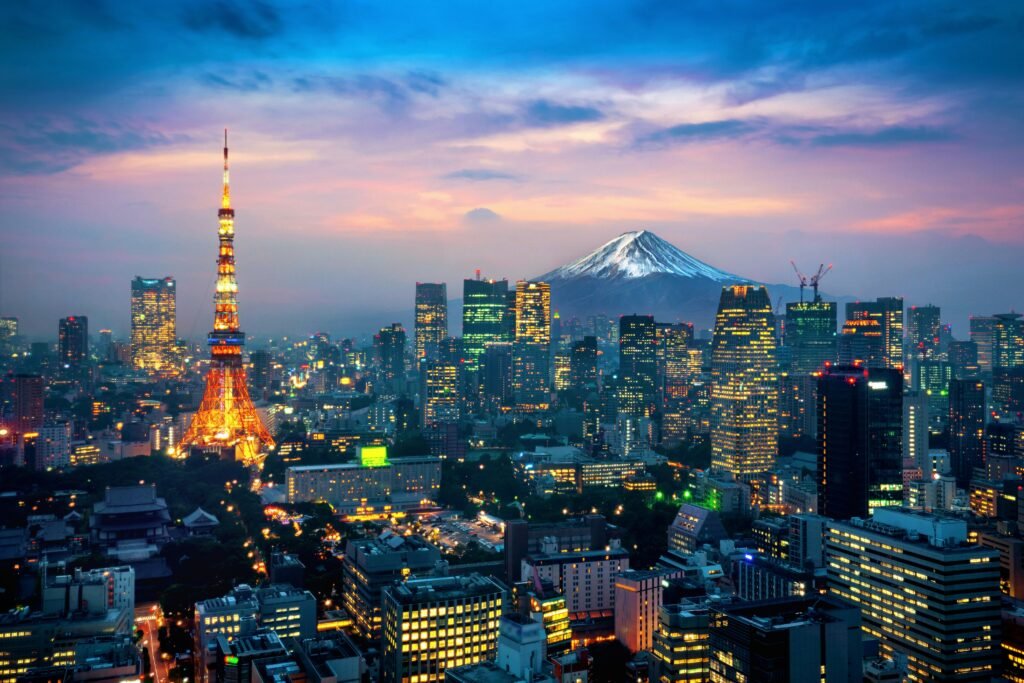
Tokyo is massive. Really massive. Its scale, the endless neighborhoods, the constant rush of people — it’s a bit overwhelming at first. The Greater Tokyo Area is one of the most densely populated urban zones on the planet. Just imagine: 38 million people navigating the city every single day. For comparison? Greater Paris clocks in at just around 12 million. Tokyo? It’s in a league of its own.
Goodbye Edo, Hello Tokyo
Before 1868, the city was called Edo. When the Meiji Restoration marked the end of the shogunate and ushered in a new era, it was renamed Tokyo — literally meaning “Eastern Capital” (東京). Technically, it should be spelled “Tōkyō,” but let’s be honest, nobody wants to deal with all those accents, so we’ll keep it simple.
Tokyo’s story is one of resilience. The Great Kanto Earthquake in 1923 and the devastating bombings of World War II both left the city in ruins. Yet, it rebuilt itself — and now it’s a fascinating mix of ultramodern towers and traditional wooden homes tucked into old neighborhoods that have withstood the test of time.
Why You Need a Game Plan to Explore Tokyo
When visiting Tokyo, planning is your best friend. Don’t waste hours zigzagging all over the city by jumping from one metro line to another. Trust me, the size of this place makes that a losing strategy. Instead, map out your days by area.
Example? Don’t try to cram Shinjuku, Akihabara, and Ginza into the same day. Instead, do something like Shinjuku + Yoyogi Park + Harajuku. That way, you get a rich, full experience of each zone without the stress. One day, one area — it’s the golden rule for a smooth Tokyo trip.
Day 1: Asakusa & Akihabara
Starting Your Journey in Asakusa
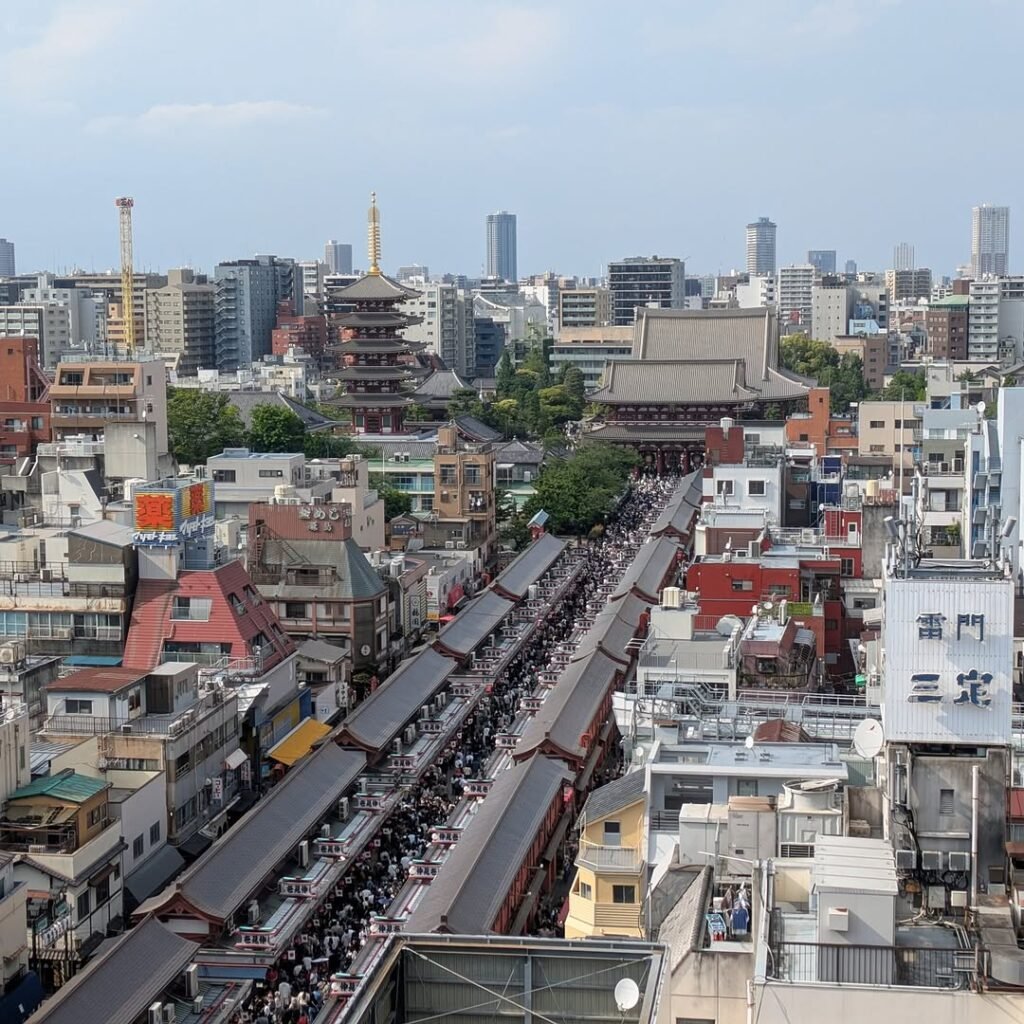
Why start in Asakusa? For one, it’s home to some of Tokyo’s most affordable guesthouses and a relaxed vibe — perfect when you’re still jetlagged. Plus, it’s incredibly walkable, which makes it a gentle intro to the city.
Head to Kaminarimon, or “Thunder Gate,” and say hello to the gods of wind and thunder who greet you with fierce expressions. This gate leads into Sensō-ji, Tokyo’s oldest Buddhist temple, dedicated to Kannon, the goddess of mercy. The five-tiered pagoda? Absolutely iconic.
Walk along Nakamise-dōri, a lively market street where you can try your first taiyaki — fish-shaped cakes stuffed with sweet red bean paste. Don’t rush. Take time to observe the locals at worship. Watch, and if you feel comfortable, join in. Temples and shrines are woven into daily life here — throwing a ¥5 coin, bowing, clapping, and making a wish is all part of the rhythm of Tokyo.
When you leave the temple grounds, check out the little covered shopping arcades around. Try a pickled vegetable sample if a shopkeeper offers — it might look odd, but it’s often delicious. And yes, you should try everything that’s offered. That’s part of the fun.
Local tip: If you’re visiting in mid-May, don’t miss the Sanja Matsuri — one of Tokyo’s biggest festivals. Crowds, drums, traditional dancing, and Shintō deities parading on portable shrines. Book accommodation in advance if you want to stay in Asakusa — it gets packed!
Cross to Akihabara — Tokyo’s Geek Paradise
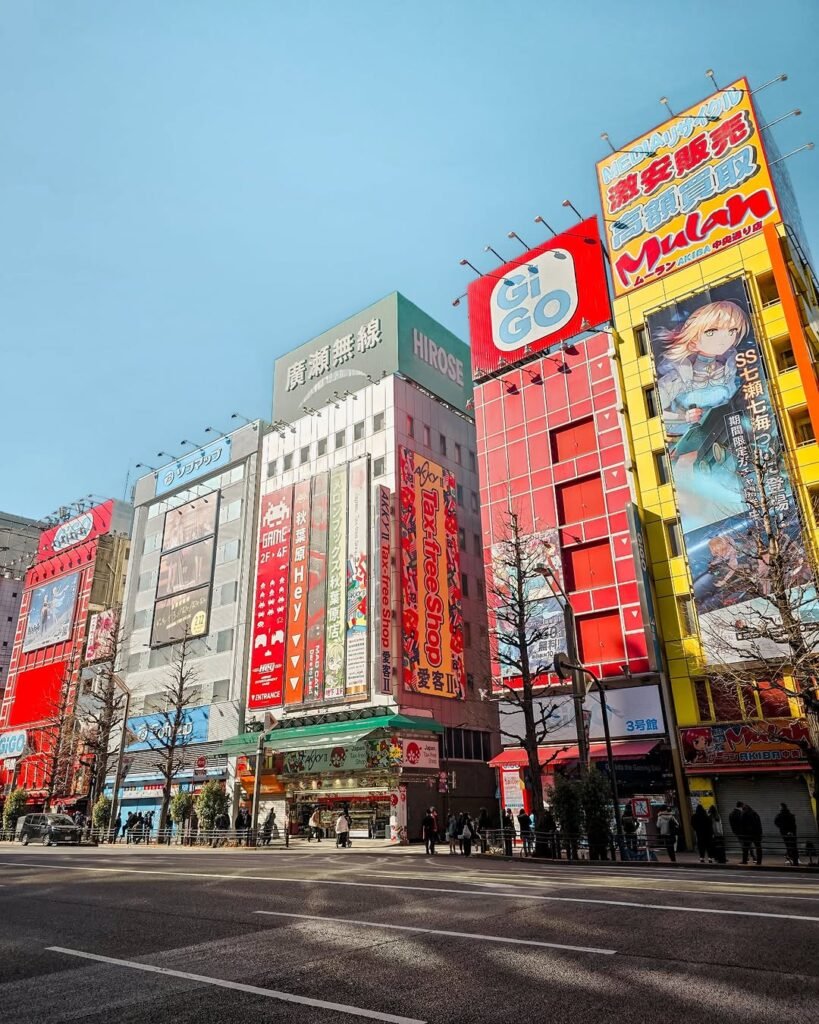
Not far from Asakusa lies Akihabara (aka Akiba), the otaku capital of the world. Even if anime and gaming aren’t your thing, this place is worth seeing. You’ll find endless electronics shops, manga stores, cosplay cafés, and arcades that are an experience in themselves.
Curious? Step into a random shop, even the weird ones — especially the weird ones. From massive chain stores like Yodobashi Camera to tiny niche boutiques, this neighborhood is a crash course in Japanese pop culture.
If you’re into books, hunt for deals at Book-Off, a secondhand chain full of hidden gems. And if you’re brave, peek inside a maid café — even if just for the story.
Day 2: Shinjuku, Meiji-jingū, Yoyogi Park, Harajuku & Shibuya
Lace Up — This Day Is All About Exploring on Foot
Time to put on your comfiest shoes — today’s route is best done on foot, with a few train rides if needed. Grab your city map (digital or old-school paper, your call), charge your phone, and let’s hit the streets.
Morning in Shinjuku: Tokyo’s Business Beast
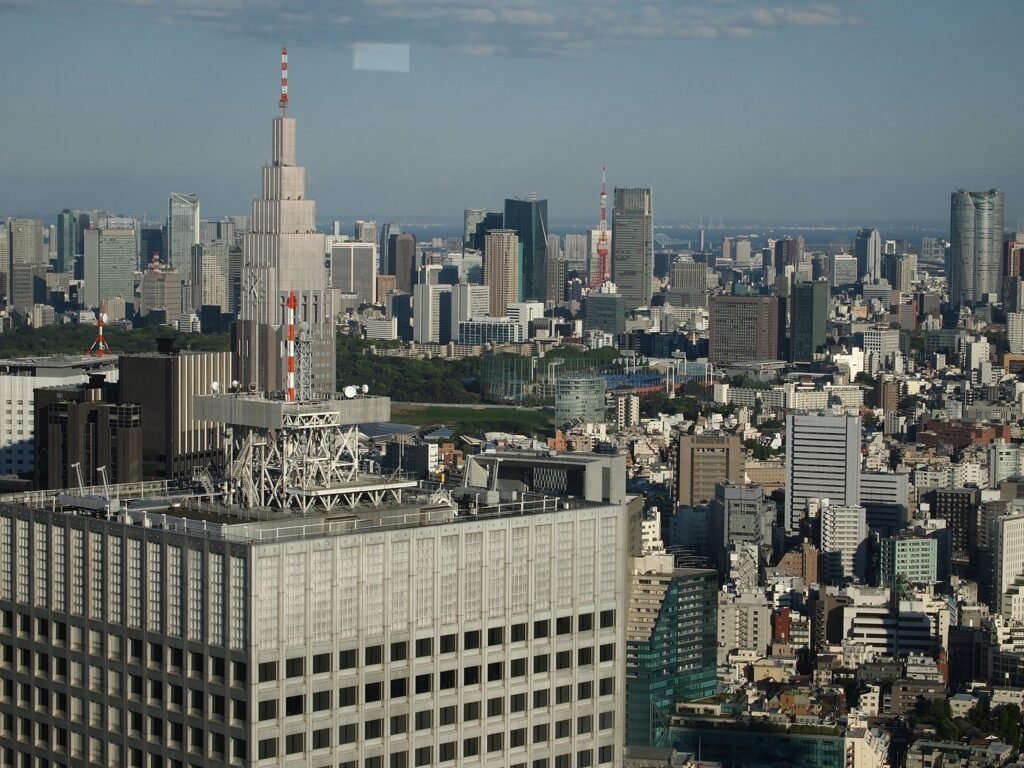
Start your day in Shinjuku, the beating heart of Tokyo’s business district. You’ll be surrounded by skyscrapers, neon signs, and a fast-paced buzz that screams “city life.” The architecture alone is worth gawking at — sleek lines, mirrored surfaces, curves and edges that look like they belong in a sci-fi movie.
Head toward the Tokyo Metropolitan Government Building. It’s free to enter and has an observation deck that gives you a 360° view of the city skyline from 202 meters up. On clear days, you might even spot the silhouette of Mount Fuji in the distance. Free views like this are a rare find in Tokyo, so don’t skip it.
Golden Gai by Night: The Secret Side of Shinjuku
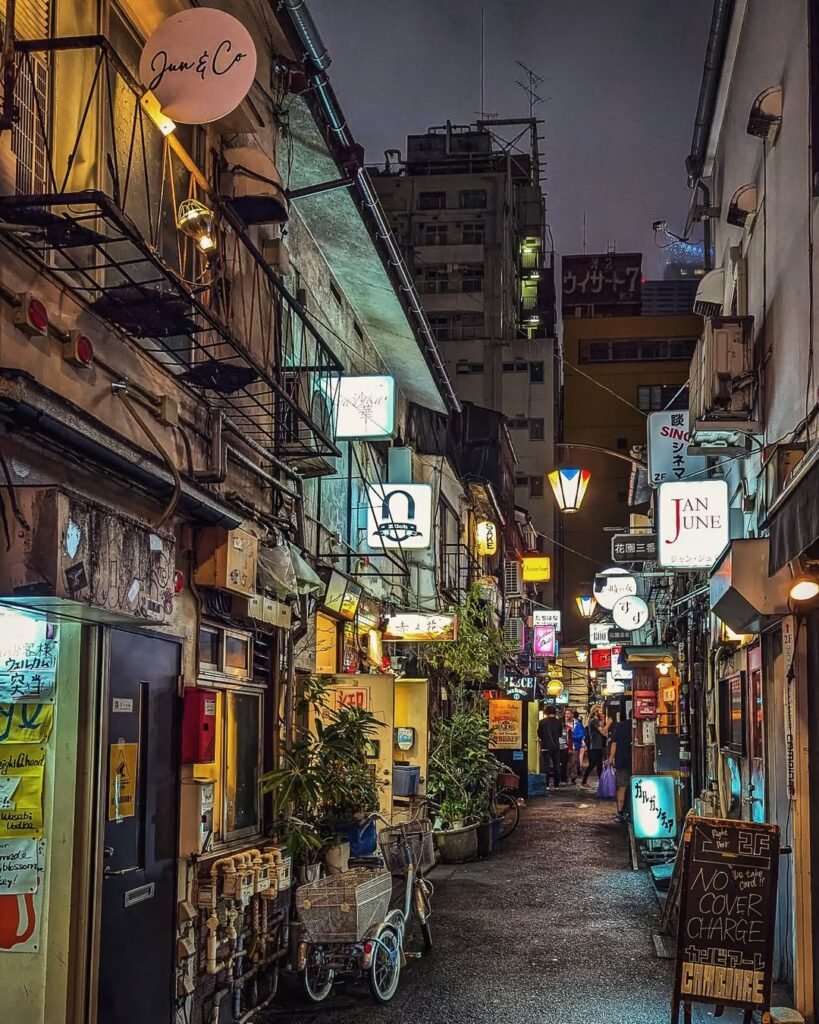
You might want to circle back here after dark for a completely different vibe. Golden Gai is a cluster of narrow alleys packed with tiny, quirky bars — some barely big enough for six people. It’s part retro, part chaotic, and totally photogenic. This area once had ties to the yakuza, and while that edge still lingers, today it’s more known for its gritty charm and lively nightlife.
Wander into Yoyogi Park
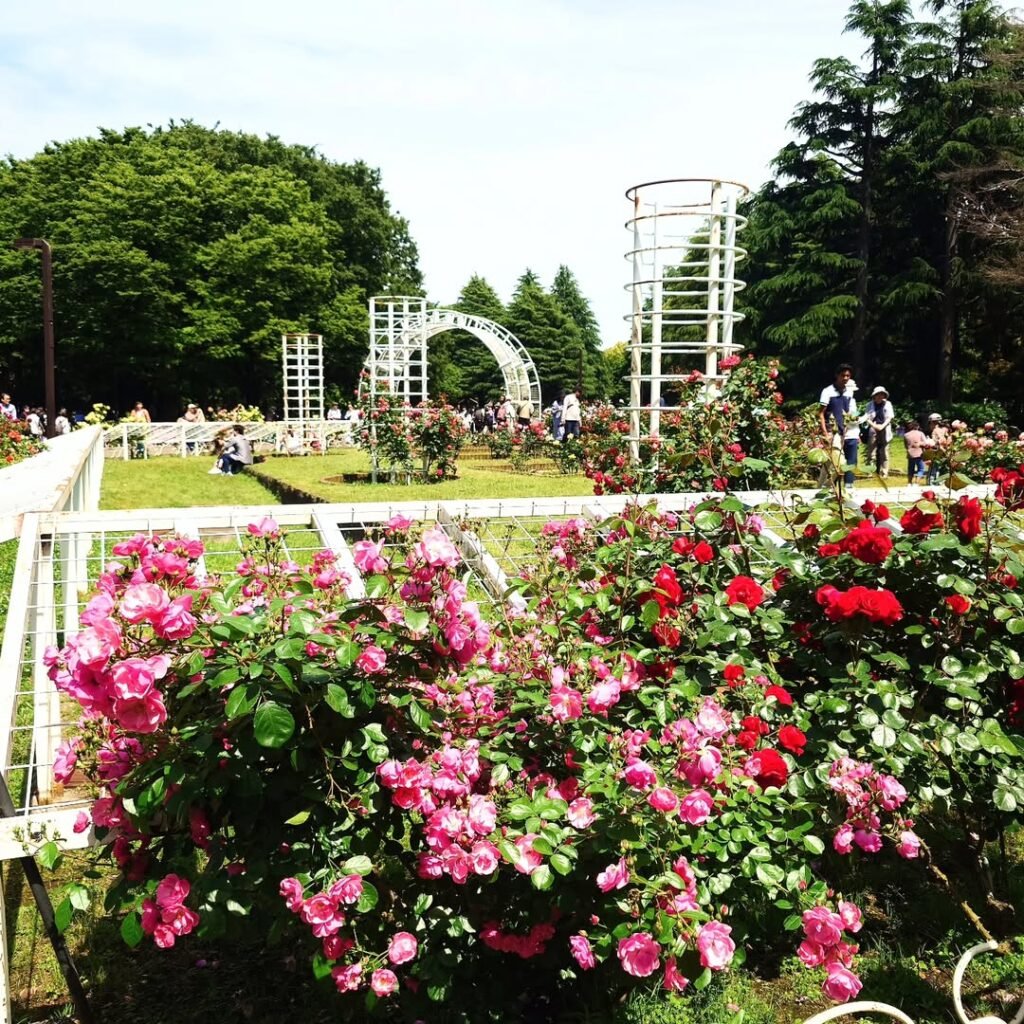
From Shinjuku, make your way south toward Yoyogi Park — one of Tokyo’s biggest green spaces. Suddenly, the steel and glass fade into trees and open skies. Welcome to one of Tokyo’s most beloved chill-out zones.
Walk under the towering torii gate and step into a forested path that leads to the Meiji-jingū Shrine — the most important Shintō shrine in the country. The shrine honors Emperor Meiji and Empress Shōken, who helped transform Japan into a modern state.
Before entering the torii gate, do as the locals do: stop, bow slightly, and walk to the side — never down the center path, which is reserved for the kami (Shintō gods). You’ll find peace, prayer boards called ema, and maybe even catch a glimpse of a traditional Japanese wedding.
Traveler tip: On weekends and public holidays, you might stumble upon a Shintō ceremony or festival procession — colorful, respectful, and oh-so-photogenic. Always ask before taking photos of people.
Harajuku: Tokyo’s Playground of Fashion
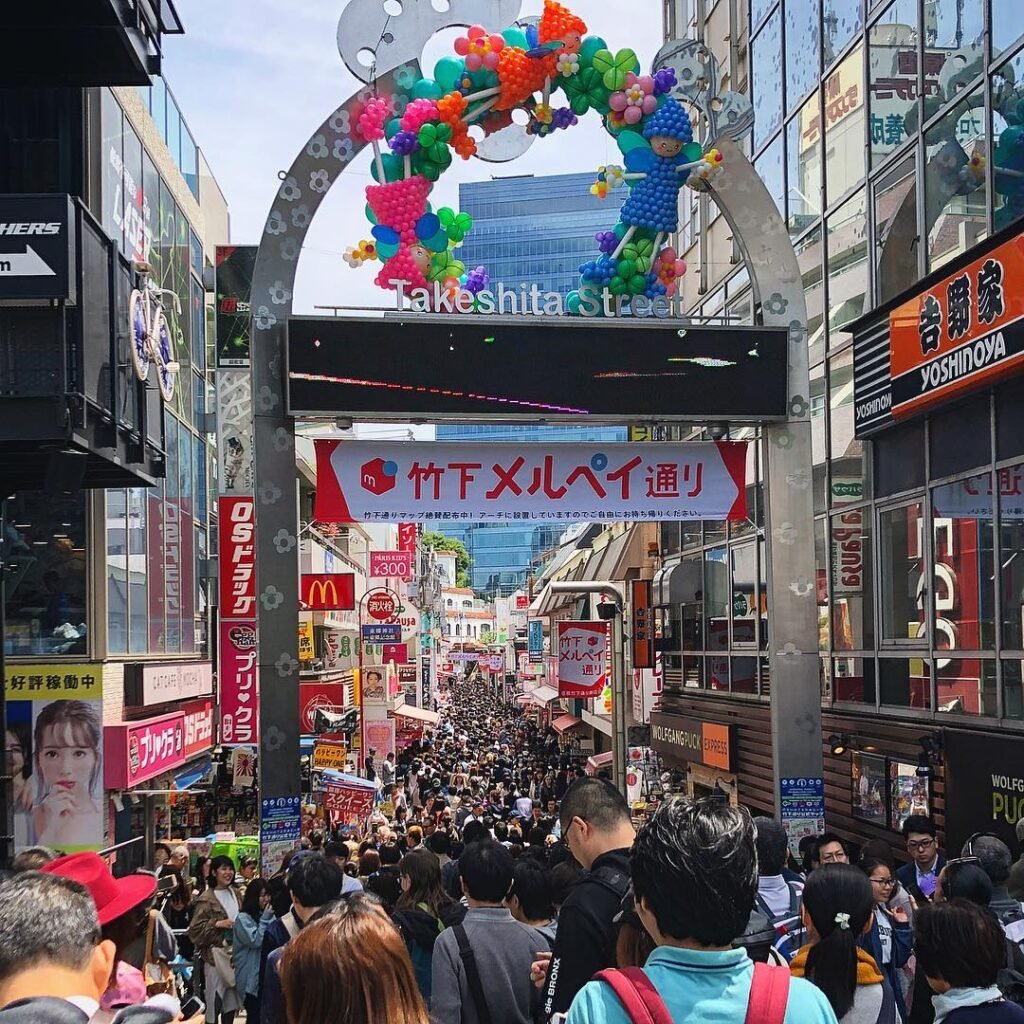
Cross the park and you’ll find yourself in Harajuku, Tokyo’s legendary youth culture district. If Shinjuku is Tokyo in a suit, Harajuku is Tokyo in full cosplay.
Explore Takeshita Street, a chaotic strip of kawaii shops, rainbow cotton candy, crepe stands, and fashion that defies logic. Think gothic Lolita next to bubblegum pink unicorns. It’s wild. It’s fun. It’s Harajuku.
Keep wandering — behind the main street are tucked-away vintage stores, artsy galleries, and niche cafés. If you love quirky culture and street fashion, this is your Tokyo paradise.
Detour to Omotesandō — Tokyo’s “Champs-Élysées”

Stroll a little further and you’ll find Omotesandō, the upscale sibling to Harajuku’s chaos. It’s where fashion gets fancy — think flagship stores like Prada, Dior, and Omotesandō Hills. Even if you’re not shopping, the architecture is worth admiring.
Window shop, grab a latte, or just soak in the cool, modern vibe. Omotesandō is one of those streets where you can feel Tokyo’s pulse — classy, edgy, and always a little unexpected.
Shibuya: The Crossing That Needs No Introduction
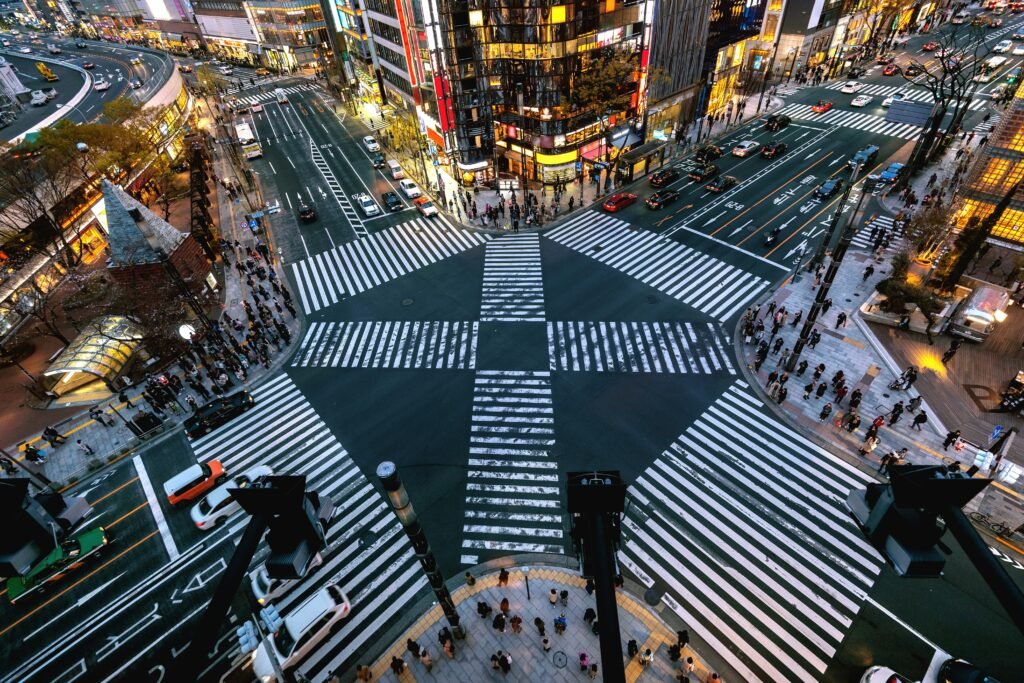
Whether you walk or hop the Ginza Line from Omotesandō, your final stop for the day is Shibuya. You’ll know you’re close when the crowds swell and the neon lights start to flash.
And then — there it is — Shibuya Crossing. Possibly the most famous intersection in the world. Wait for the light, then cross with hundreds of others in a giant, choreographed chaos of motion. Want a great view? Head to the Starbucks upstairs for a latte and a perfect window seat.
Don’t leave without saying hello to Hachikō, the loyal Akita dog whose statue sits just outside the station. His story of devotion still melts hearts — he waited every day for his master to return, even years after he passed.
Shibuya After Dark
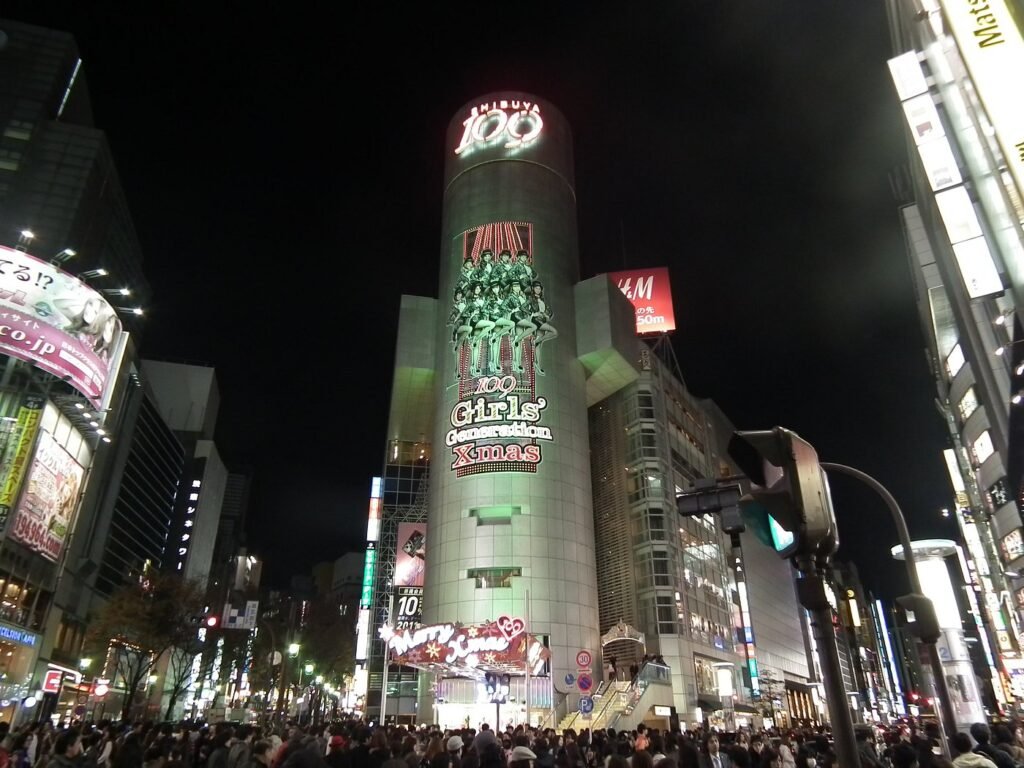
As night falls, Shibuya lights up like a futuristic carnival. Pop into MEGA Don Quijote (an anything-goes megastore), browse fashion at Shibuya 109, and explore backstreets filled with ramen joints, izakayas, and quirky bars.
This is Tokyo at its most electric — loud, crowded, and unforgettable. And after a day this full, your feet will thank you for calling it a night.
Day 3: Roppongi, Chiyoda, the Imperial Gardens & Ginza
Morning Stroll in Roppongi
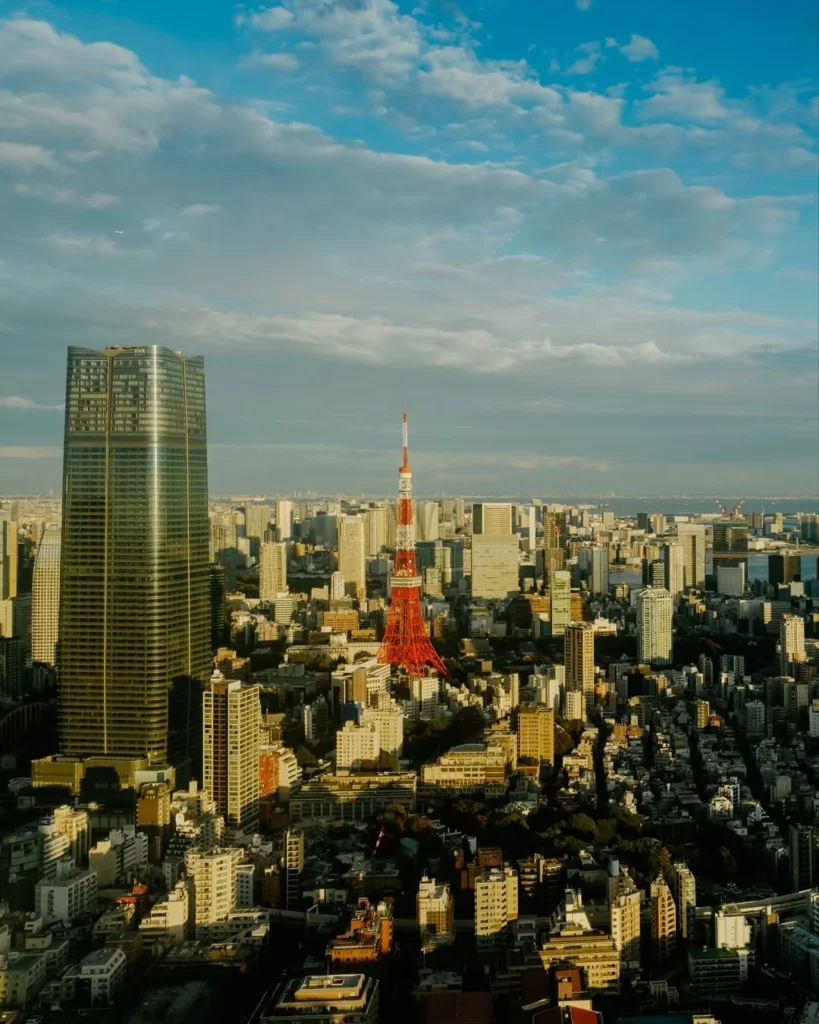
Start your day in Roppongi, Tokyo’s artsy, international, and surprisingly calm corner of the city. Step out of Roppongi Station and head toward Roppongi Hills — a sleek and stylish complex with designer boutiques, cafés, museums, and the iconic Mori Tower. Don’t miss the giant spider sculpture out front called “Maman” by Louise Bourgeois. Creepy-cool and totally Insta-worthy.
If you love art, consider visiting the Mori Art Museum at the top of the tower. The exhibitions are modern, often bold, and the view from the 52nd floor is just spectacular. If you’re not into paying for the observatory, head to the library floor a few levels down — the view is still amazing and free.
Bonus for Snoopy fans: just around the corner, near the Philippine Embassy, there’s a whole Snoopy Museum. Quirky, charming, and full of nostalgia.
Walk Toward Tokyo Tower

From Roppongi, you can take the train — but honestly? Just walk. It’s a lovely stroll past embassies and upscale homes, and you’ll catch a clear view of Tokyo Tower as it slowly comes into frame.
Built in 1958, Tokyo Tower is Japan’s take on the Eiffel Tower, only orange-and-white, and — believe it or not — slightly taller. Originally a broadcast antenna, today it’s a whole experience: observatories, shops, cafés, even a One Piece-themed floor (yes, for anime fans).
Want the view? The main deck (150m) is about ¥900, and the top deck (250m) is extra, but totally worth it if skies are clear. Not up for the fee? No worries. The base floor is free, and there’s still plenty to see — shops, food, and that unmistakable retro charm.
Zōjō-ji Temple: Tranquility Below the Tower
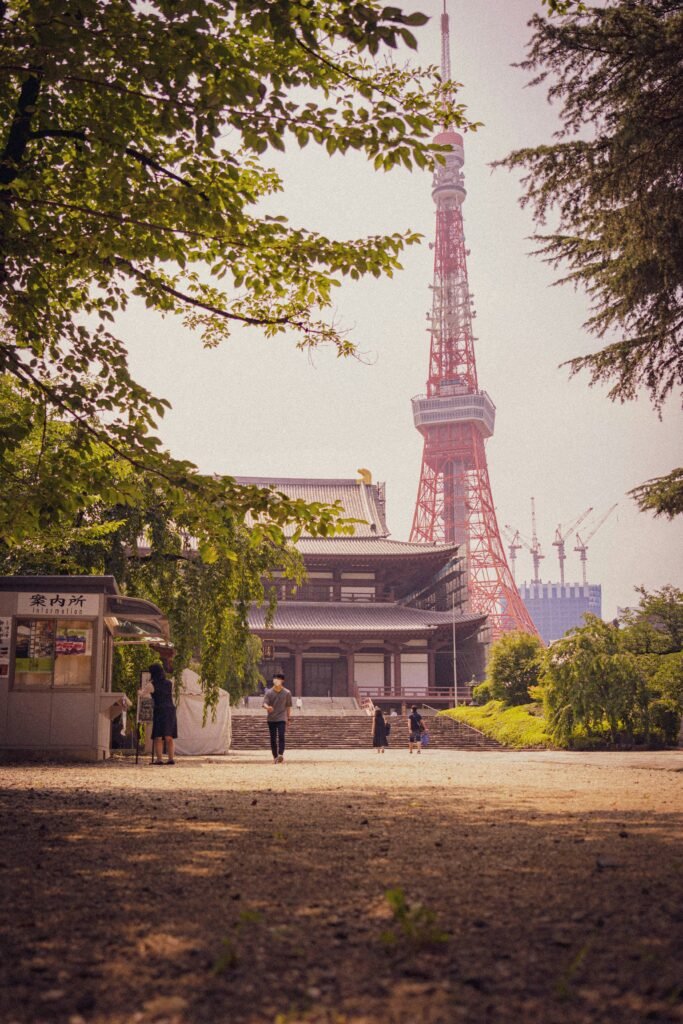
Just behind Tokyo Tower lies the peaceful, powerful Zōjō-ji Temple — a massive Buddhist complex that feels like a world apart. It’s a place of quiet reflection tucked among the urban chaos. You’ll be standing in a slice of living history.
The original gate, Sangedatsu-mon, dates back to the 1600s, and even though the temple was rebuilt after WWII bombings, it still commands a kind of reverence. You can wander inside (after removing your shoes) and observe — just be respectful if a ceremony is in progress.
Now, don’t miss the Jizō statues nearby — rows and rows of little stone figures with red bibs and wool hats, sometimes surrounded by toys and pinwheels. These represent lost children and are placed there by grieving families. It’s sobering, moving, and unforgettable.
If you have time, visit the Tokugawa Mausoleum, resting place of one of Japan’s most powerful historical families. This place isn’t just spiritual — it’s deeply tied to the story of Japan itself.
Head to Chiyoda: The Heart of Imperial Tokyo
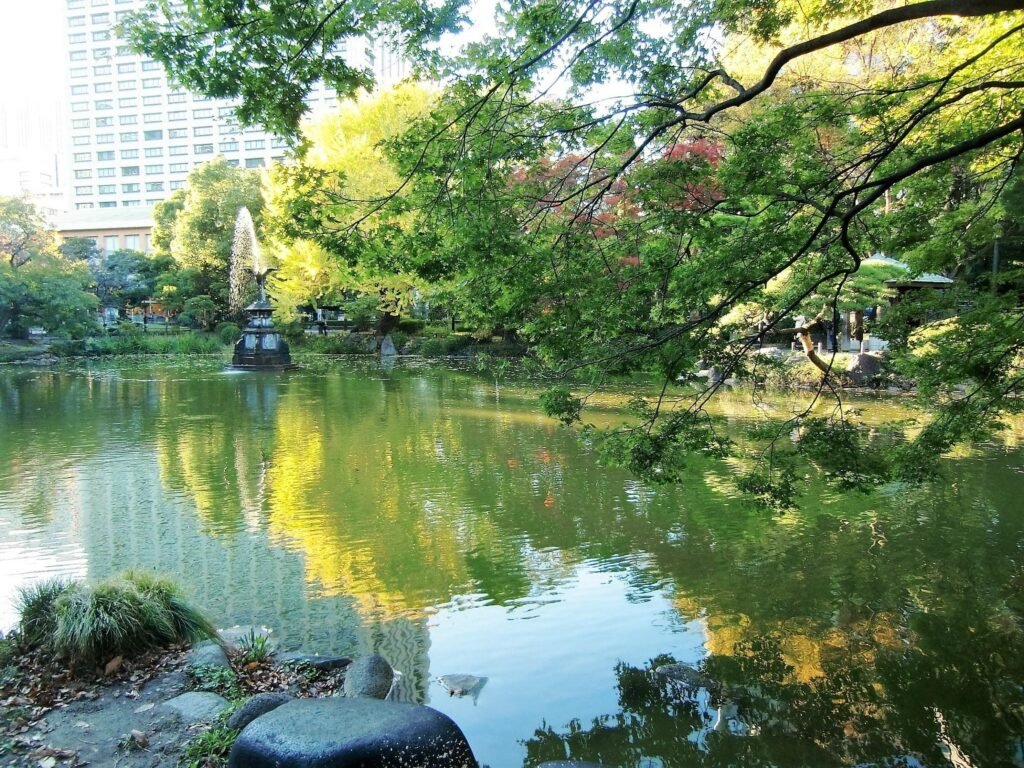
Hop on the Mita Line (Toei) at Onarimon Station and head to Hibiya Station. You’re now entering Chiyoda, the district that houses the Imperial Palace, the National Diet, and some of the most important government buildings in Japan.
Take a peaceful walk through Hibiya Park, then head toward the Seimon Bridge. No, you can’t cross it — it’s the entrance to the Imperial residence — but it’s lovely to look at. The mix of stone bridges, pristine gardens, and skyscrapers in the background is Tokyo in a nutshell: old meets new, past meets future.
If you’ve got extra time, walk the entire Imperial Palace grounds — it’s huge, green, and surprisingly quiet. A solid choice if you’re feeling a little overstimulated.
Afternoon Elegance in Ginza
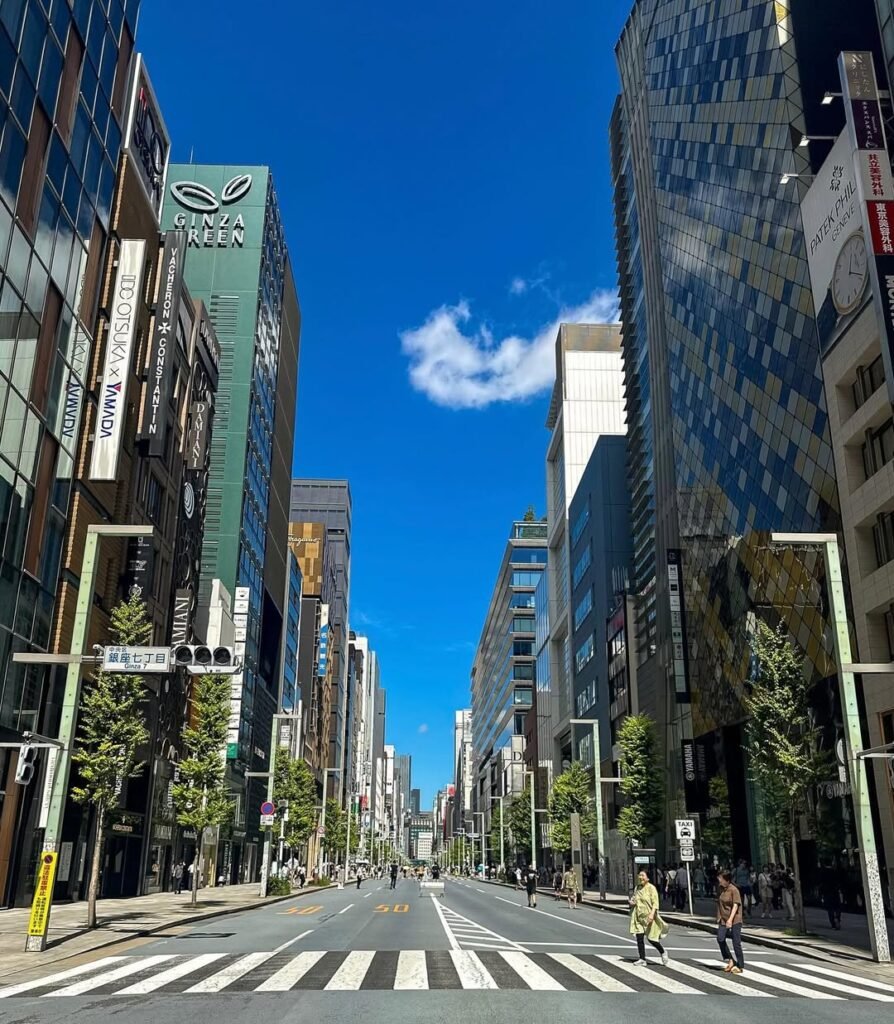
Now it’s time to wrap the day in style — and there’s no better place than Ginza. Take the subway (or walk, if you’re feeling ambitious) and head straight to Chūō-dōri, Ginza’s main shopping street.
Ginza is Tokyo’s luxury capital. Towering flagships of Chanel, Prada, and Louis Vuitton sit shoulder to shoulder with giant Uniqlo, Zara, and Muji stores that span several floors. And when night falls, the whole place glows — literally — with signs, lights, and reflections that dazzle from every direction.
Don’t care about shopping? No problem. Ginza has hidden gems:
- Art galleries tucked above shops
- Elegant tea stores with tasting corners
- Boutiques selling hand-crafted washi paper
- The Kabuki-za theater, if you want to try Japanese performance art (yes, you can buy tickets for a single act!)
Sunday tip: The main street is closed to cars on Sundays, turning the whole area into a pedestrian paradise. The vibe is mellow, and the shops are all open.
End the day with a wander, a drink in a high-floor lounge bar (if your budget allows), or even just a sit on a public bench, watching Tokyo sparkle.
Day 4: The Ghibli Museum, Tokyo Dome City, and a Return to Asakusa
A Morning in Mitaka: Welcome to the World of Ghibli
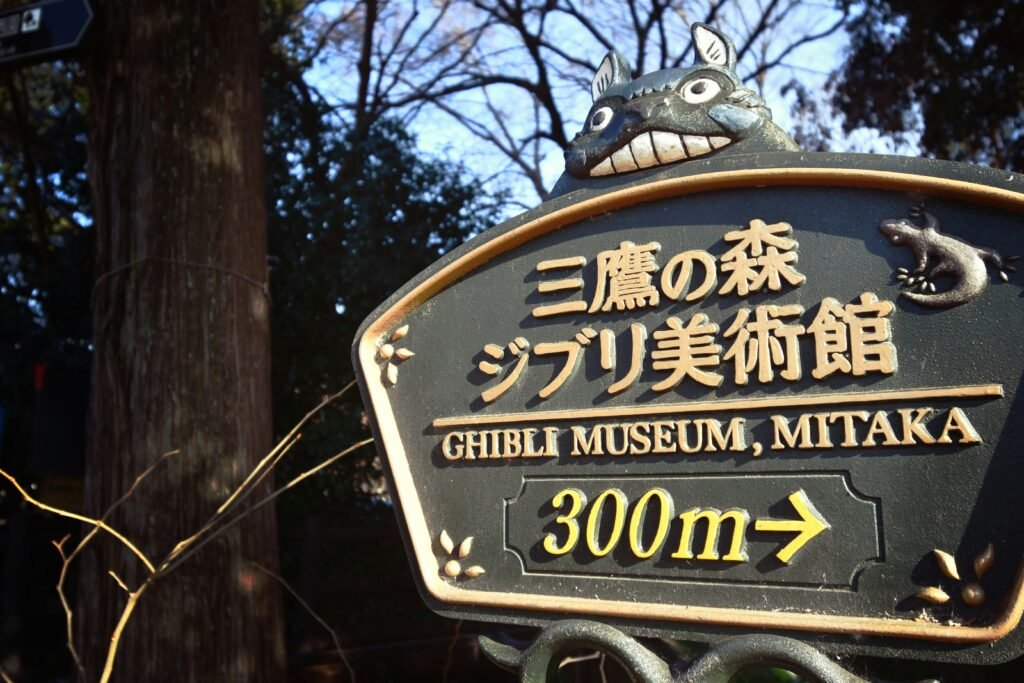
Today starts with a mini escape — to the quiet suburb of Mitaka, where the Ghibli Museum brings Studio Ghibli’s worlds to life. If you grew up loving My Neighbor Totoro, Spirited Away, or Howl’s Moving Castle, you must come here. It’s magical.
Important: Tickets are limited and must be booked in advance. You can grab them on their website. They go fast, so don’t wait. Expect to pay around ¥1000–per adult.
Take the JR Chūō Line to Kichijōji Station, then walk through the lovely Inokashira Park — a peaceful detour with ponds, temples, swan boats, and maybe a stray cat or two — until you see Totoro at the Ghibli Museum entrance.
Inside? It’s a dreamworld. Sketches, original animation reels, life-sized recreations, a mini cinema screening Ghibli shorts, and a rooftop garden with a towering Laputa robot. Photos aren’t allowed inside — but maybe that’s the point. You’re not meant to scroll. You’re meant to wonder.
With kids? This place is a total joy. With no kids? It still is.
Back to Tokyo: The Tokyo Dome & a Dash of Madness
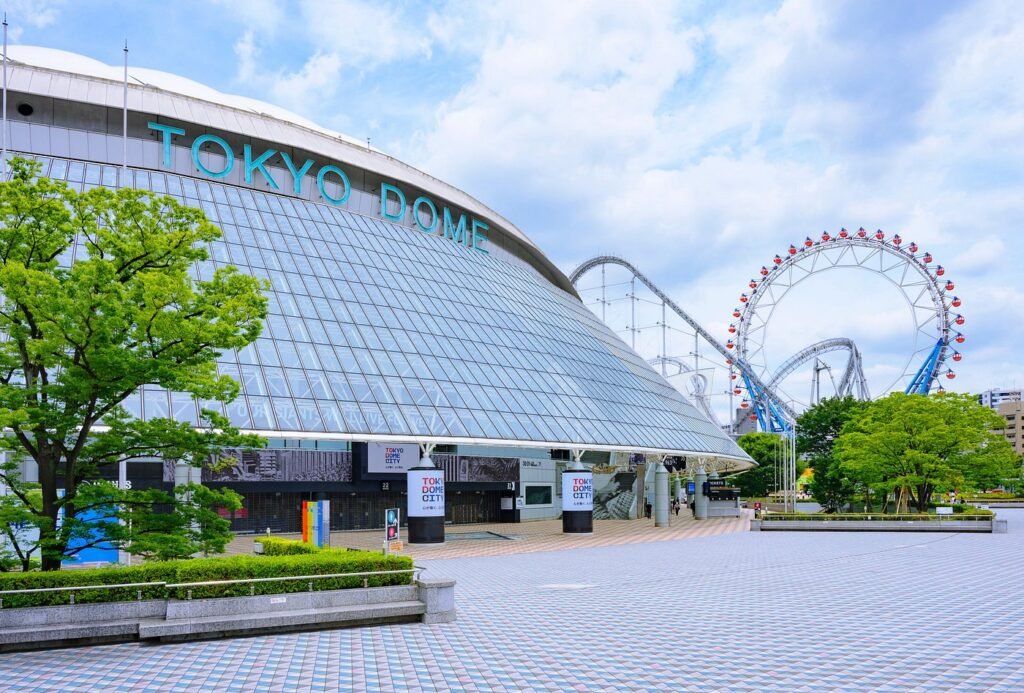
Hop on the JR Chūō Line again and head back toward Suidōbashi Station — your gateway to Tokyo Dome City, a surreal combo of amusement park, shopping center, and giant stadium.
Yes, the Tokyo Dome is where baseball fans come to cheer on the Yomiuri Giants, but the real action is around it. This complex is wild:
- The Thunder Dolphin roller coaster (yes, it flies through a building!)
- A giant Ferris wheel
- LaQua — a hot spring complex that taps geothermal waters from deep below Tokyo
- Jump Shop and Sega arcade stores for manga and game lovers
- TGI Fridays if you’re craving a little American nostalgia
If you’re not into rides, just enjoy the energy — and then seek balance in the quiet corner just behind the Dome…
Koishikawa Kōrakuen Garden: Peace in the Middle of It All
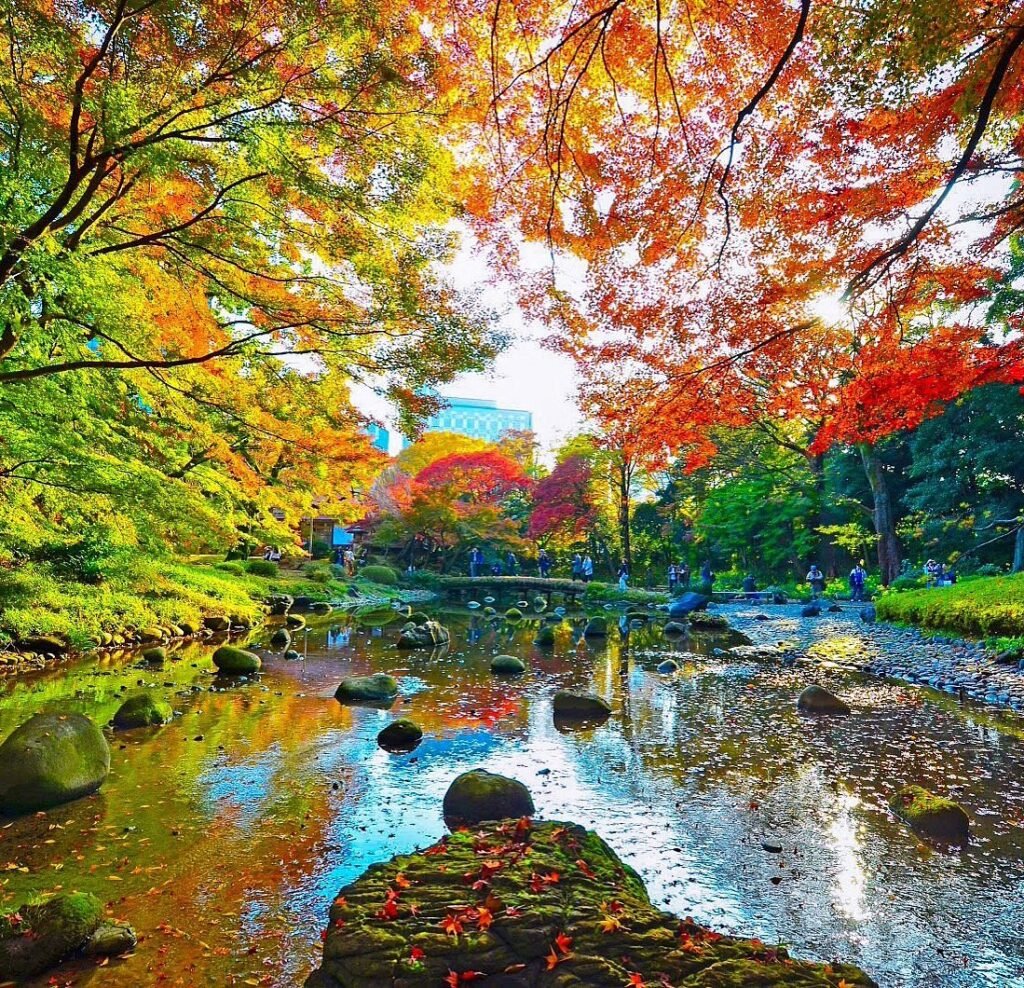
Right next to the chaos of Tokyo Dome City is one of Tokyo’s most beautiful traditional gardens — Koishikawa Kōrakuen. With its carefully shaped ponds, stone bridges, maple groves, and seasonal flowers, this 17th-century garden was designed to reflect Chinese and Japanese philosophies of harmony.
Wander through winding paths, stumble upon lanterns, and if you’re lucky, catch seasonal blossoms or fall foliage. It’s like a reset button for your brain.
Evening in Asakusa: Back Where You Began
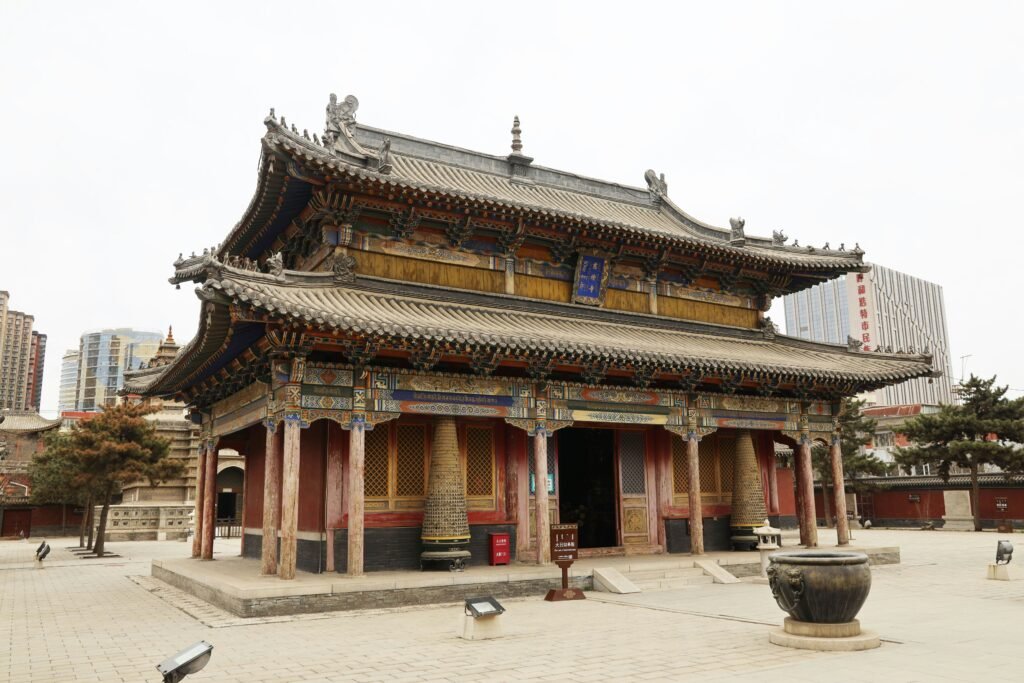
Wrap up your day with a quiet return to Asakusa. If your first day here was a bit rushed (or jetlagged), this is your chance to really soak it in. Evening brings a softer side to the neighborhood:
- Sensō-ji Temple glows under lantern light
- The shops along Nakamise-dōri are closing, but some food stalls linger
- You can stroll along the Sumida River, with Tokyo Skytree gleaming in the distance
- Or simply grab a seat at a tiny izakaya and treat yourself to yakitori and a cold beer
No plans. Just vibes. That’s what evenings in Asakusa are for.
Day 5: Tsukiji Market, Nippori Fabric Town & Ueno Park
Rise and Shine at Tsukiji Fish Market
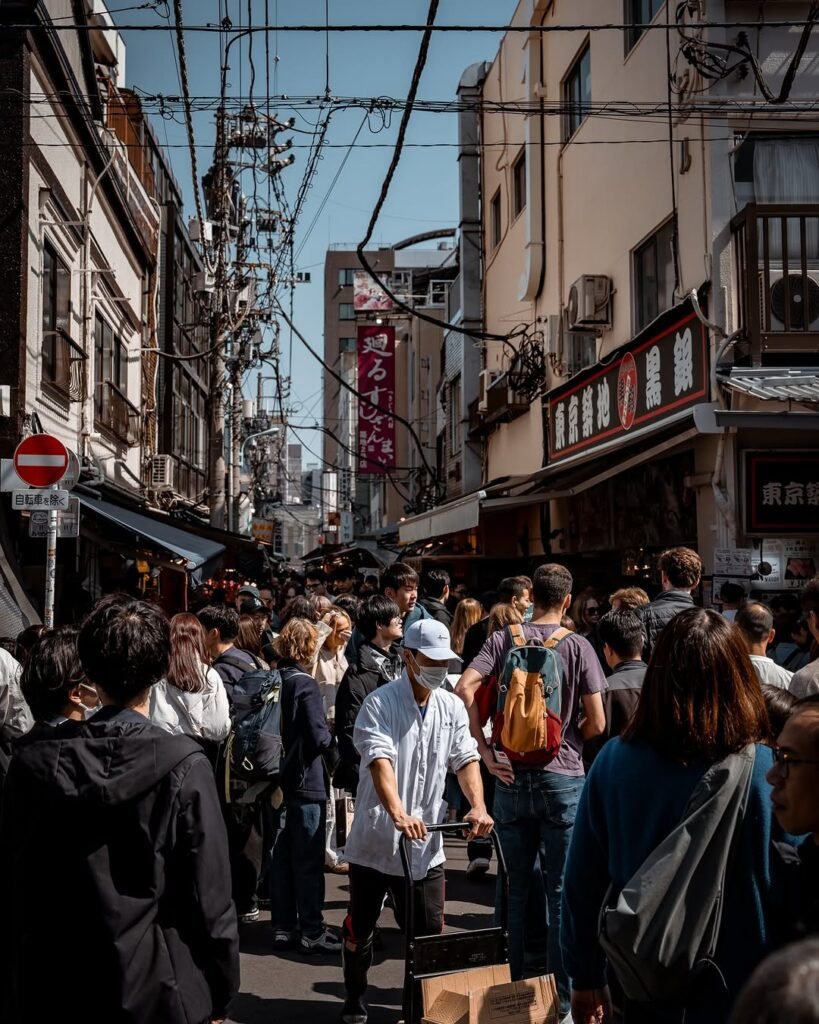
If there’s one day to set an alarm, it’s this one. You’re off to Tsukiji, the most famous fish market in the world — and yes, it still buzzes with energy, even though the wholesale auction has moved to Toyosu.
Take the Hibiya Line to Tsukiji Station or the Oedo Line to Tsukijishijō Station. Step out, and you’ll immediately catch a whiff of salt, sea, and sizzling skewers.
While the inner market has shifted, the outer market is still alive with:
- Fresh sushi restaurants (perfect for a breakfast like no other)
- Food stalls selling grilled scallops, tamagoyaki (sweet omelet on a stick), and tuna skewers
- Knife shops, tea vendors, wasabi root displays, and piles of gleaming seafood you’ve never seen before
Pro tip: Go after 10 AM — the working market folks aren’t big on crowds before that. Also, wear shoes with grip (it gets slick!) and be mindful of the fast-moving carts and bikes.
Before you leave, stop by the nearby Tsukiji Hongan-ji Temple — its architecture is a fascinating blend of Indian, Buddhist, and Western styles. You weren’t expecting that after all the tuna, were you?
Stroll to Hamarikyu Gardens (Optional but Lovely)
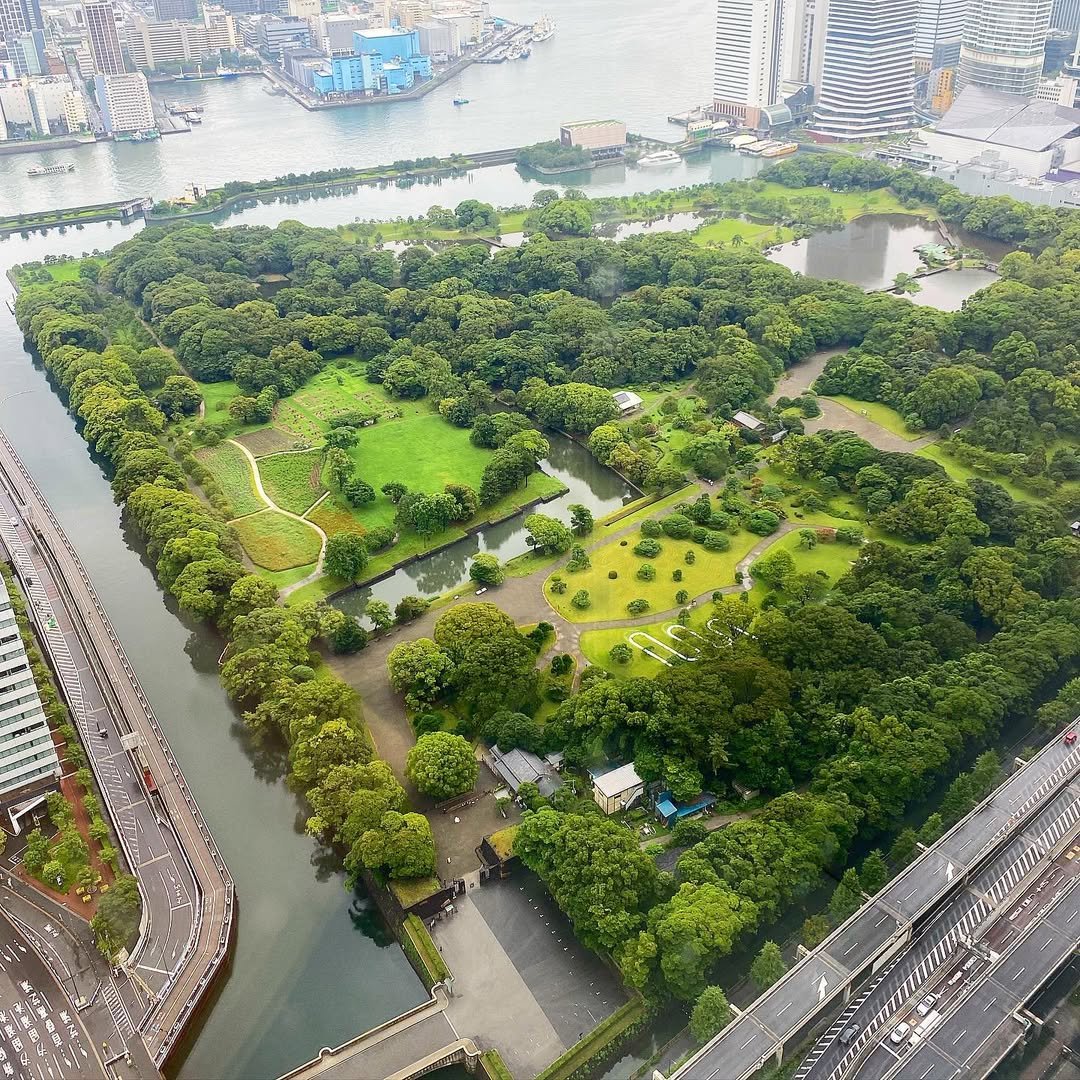
Just a short walk away lies Hamarikyu Gardens, a former feudal lord’s estate turned elegant waterfront garden. Think peaceful ponds, fields of mustard blossoms in spring, and a traditional tea house floating on the water. It’s a great place to slow down before heading back into the bustle.
Fabric, Kimonos & Hidden Treasures in Nippori
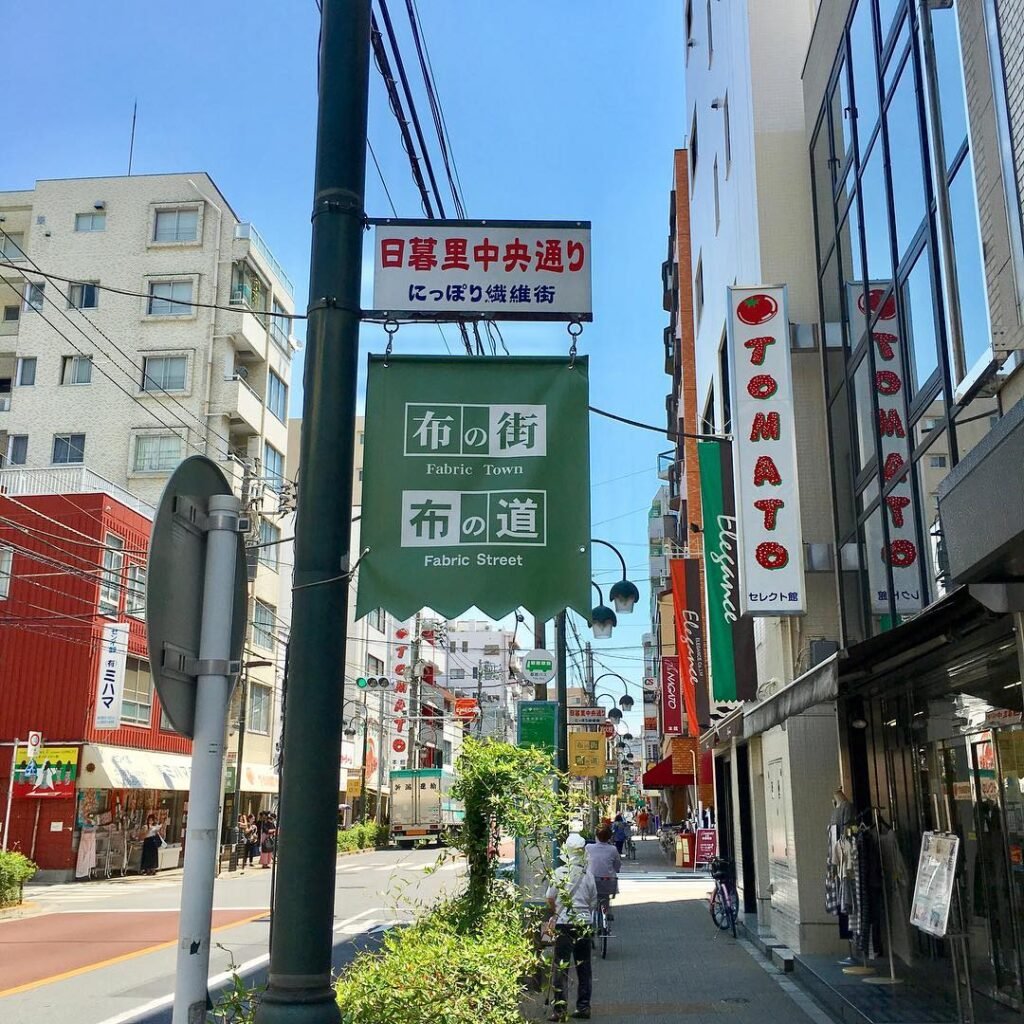
Hop on the Yamanote Line to Nippori Station — welcome to Fabric Town (a.k.a. Nippori Textile Street).
At first glance, this old Tokyo neighborhood doesn’t scream “must-see.” But give it a minute — this area is a goldmine for anyone who loves textiles, crafts, or vintage Japan.
What’s here?
- Tomato, the legendary multi-floor fabric emporium
- Shops selling Japanese cotton, indigo-dyed yukata cloth, and even vintage kimono fabrics
- Discount kimono shops with racks full of gorgeous, affordable finds
- Quirky accessory stalls, buttons, zippers, and everything in between
Even if you’re not a crafter, it’s a fun, quiet stroll through a hyper-local corner of the city — totally off the tourist radar.
Afternoon at Ueno Park: Culture & Calm
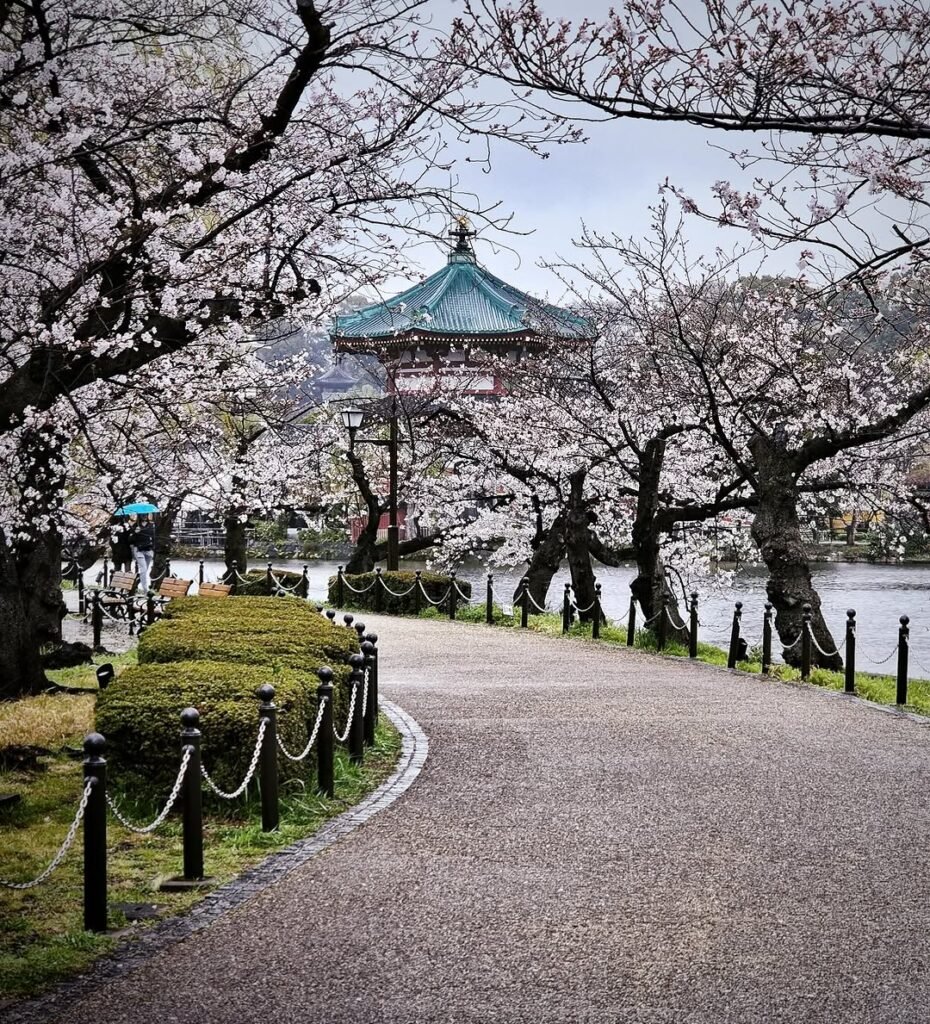
From Nippori, either walk (about 15–20 minutes) or hop back on the Yamanote Line to Ueno Station. Now, time to get your cultural fix at Ueno Park.
This massive park isn’t just green space — it’s packed with treasures:
- The Tokyo National Museum — Japan’s oldest and one of its best
- The National Museum of Nature and Science
- Art museums, including the Tokyo Metropolitan Art Museum and the quirky Ueno Royal Museum
- Temples, a large Shintō torii, hidden shrines
- Ueno Zoo — only if you’re really keen, but it’s not a must
Don’t forget to say hello to the real, taxidermied Hachikō inside the Science Museum if you want closure after meeting his statue in Shibuya.
When your feet need a break, rent a rowboat or swan paddle boat on Shinobazu Pond. You’ll float past lotus flowers and turtles, with the city skyline shimmering in the water.
In spring? It’s a cherry blossom wonderland. In winter? A bit quieter, but still full of charm.
Dinner Nearby or Return to Your Favorite Spot
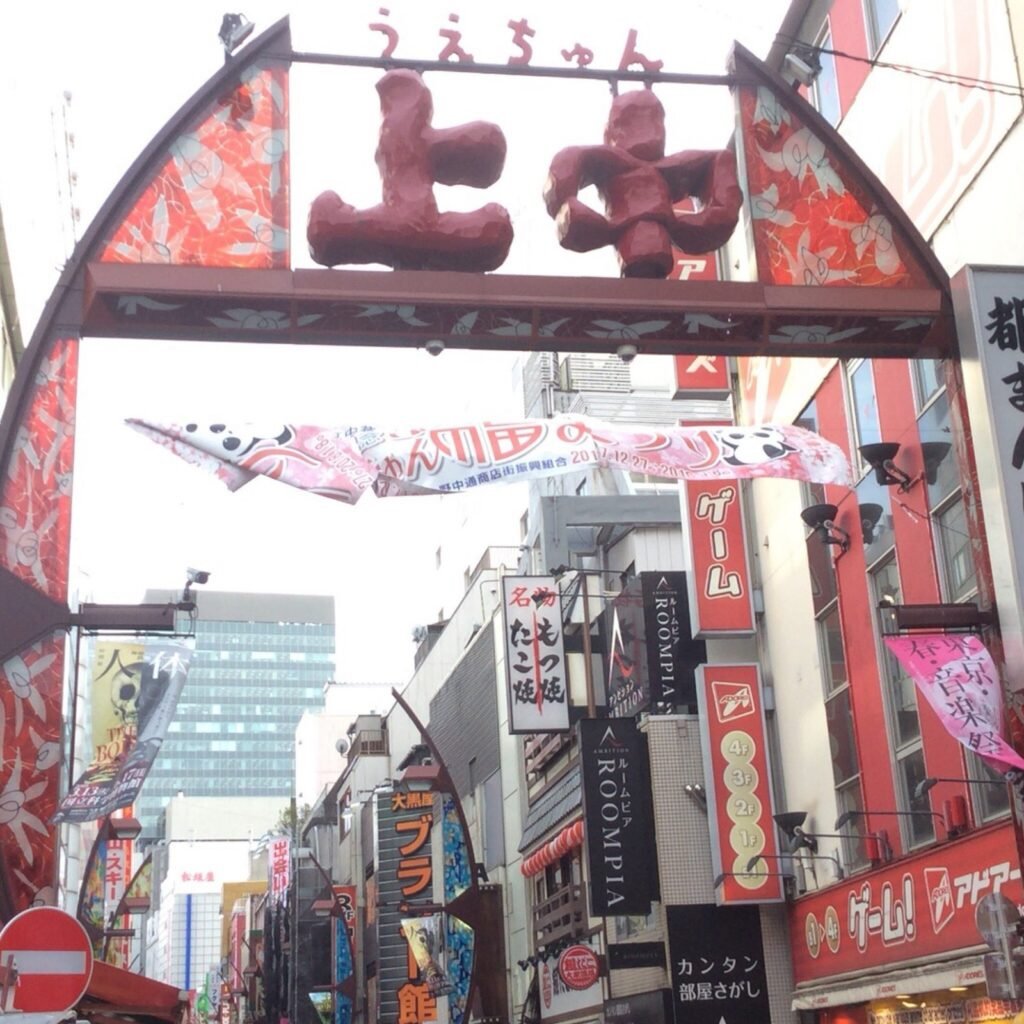
By now, you might be ready to crash — or you might still have energy for ramen, izakaya snacks, or one more temple. You’re close to Ameya-Yokochō, a bustling shopping street full of cheap eats and yakitori joints. Great for a casual, tasty dinner.
Or take the train back to Asakusa or Shinjuku — whatever part of the city is starting to feel like your Tokyo “home base.”
Day 6: Edo-Tokyo Museum, Hokusai Museum, Kappabashi Street & Tokyo Skytree
Dive into the Past at the Edo-Tokyo Museum
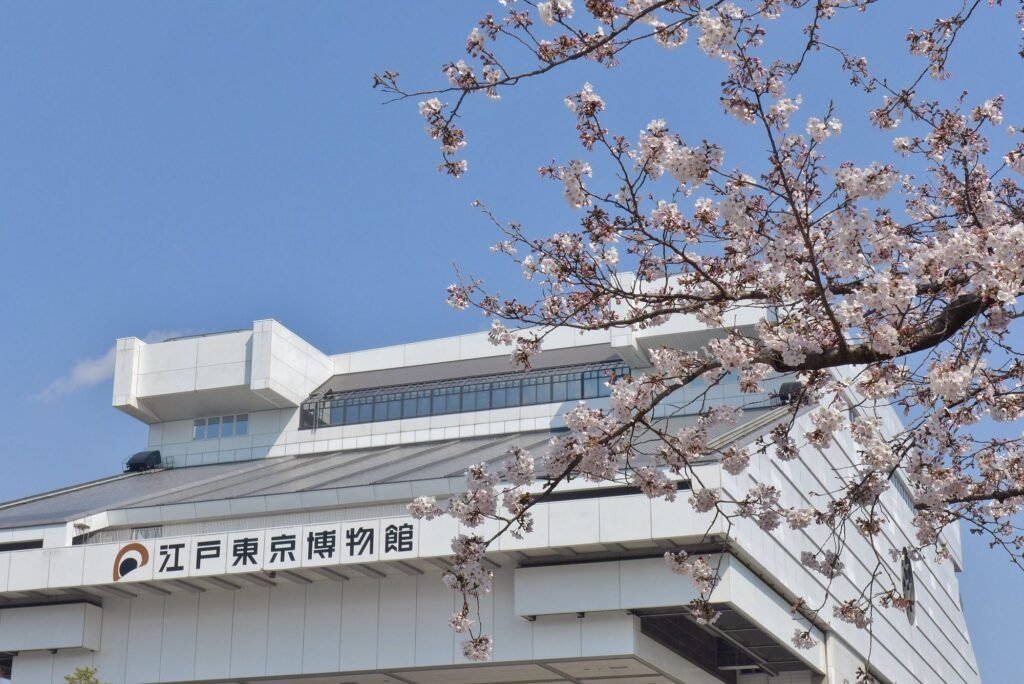
Start your morning by taking the Toei Oedo Line to Ryōgoku Station — home of sumo wrestling and one of Tokyo’s most underrated museums: the Edo-Tokyo Museum.
This place is huge. And awesome.
Inside, you’ll walk across a replica of the Nihonbashi Bridge, peek inside traditional Edo-period homes, and get face-to-face with the evolution of Tokyo — from samurai and merchant times to post-war neon chaos.
It’s interactive, it’s spacious, it’s cheap (¥600 per adult), and it’s perfect if your legs are tired from nonstop exploring — because most of the exhibits are actually fun to browse slowly.
If you’re lucky, you might even catch a demo with old-school printing tools, storytelling performances, or calligraphy stations.
Note: Ryōgoku is also home to the national sumo stadium (Kokugikan). Even if there’s no tournament on, the area oozes with sumo culture — and you might spot a few wrestlers heading to training.
Art Stop: The Sumida Hokusai Museum
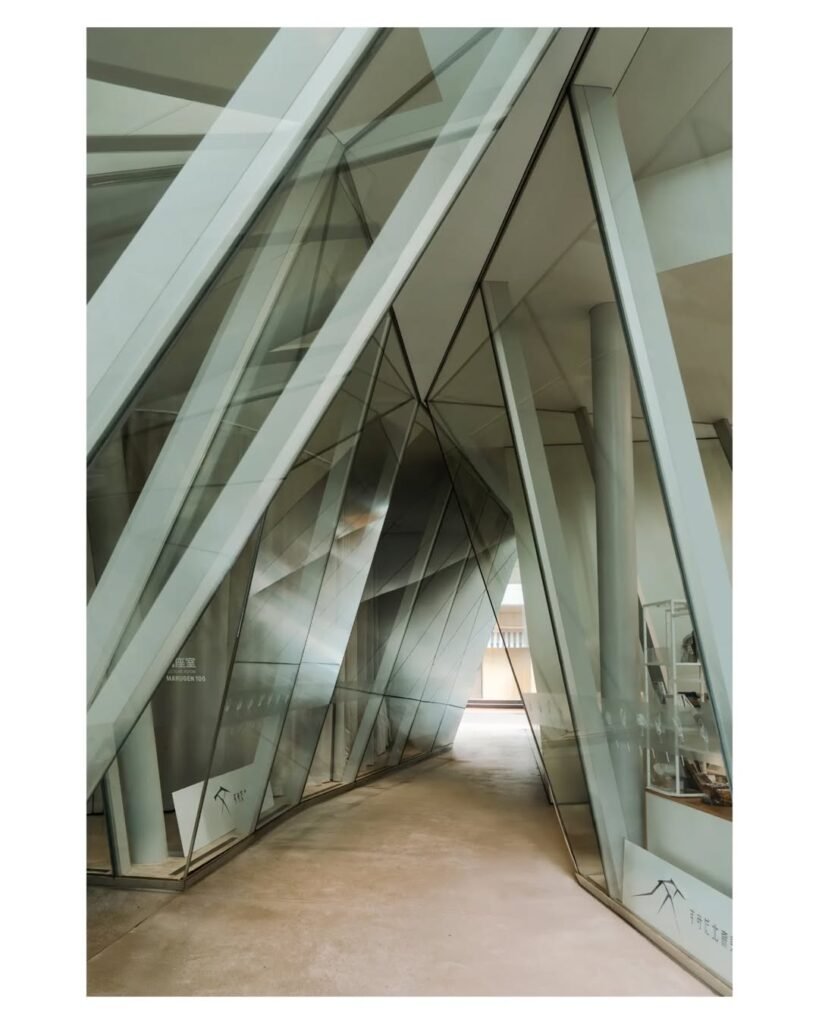
Just a 10-minute walk away is a sleek, silver building that looks like it landed from the future: welcome to the Sumida Hokusai Museum.
If the name rings a bell — yes, Katsushika Hokusai, the artist behind The Great Wave off Kanagawa.
This museum is a love letter to his life and works. Over 1,500 pieces, a rotating lineup of temporary exhibitions, and a vibe that’s clean, peaceful, and design-forward. Even the gift shop is a win.
It’s compact, but beautiful — and tickets are just ¥400. If you love Japanese art, you’ll absolutely geek out here.
Lunchtime + Wandering Kappabashi Street: Tokyo’s Kitchen Town
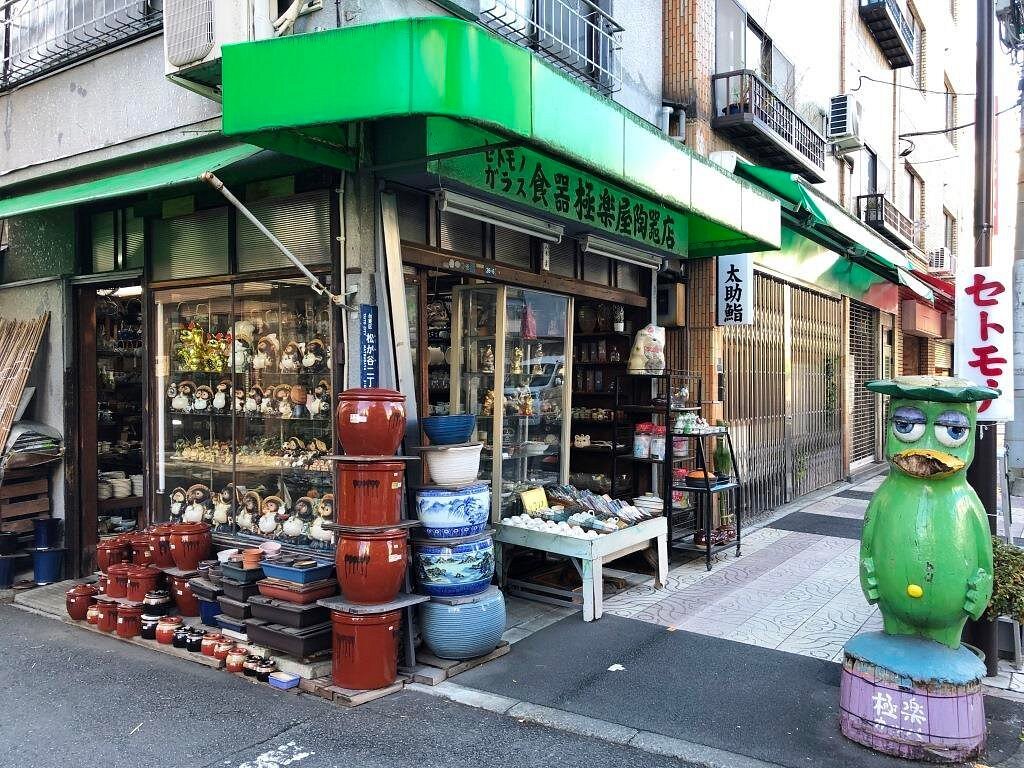
Next, head back across the Sumida River toward Asakusa, and let’s talk about Kappabashi-dōri — a.k.a. Kitchen Town.
This long, unassuming street is a secret treasure for chefs, food lovers, collectors, and anyone who likes peeking inside strange little shops.
You’ll find:
- Hand-crafted Japanese knives
- Endless stacks of ceramic bowls, tea cups, ramen spoons
- Quirky things like chopstick rests shaped like koi fish
- And best of all: those fake plastic food displays you see in restaurant windows — sushi keychains, ramen magnets, and even full-size bowls of tempura for sale
You don’t need to be a chef to enjoy this place. It’s like a flea market for the soul of Japanese food culture.
While you wander, grab a karaage snack or a croquette from a stall. This is one of the most casual, offbeat, and smile-inducing streets in Tokyo.
Afternoon/Evening: The Tokyo Skytree Experience
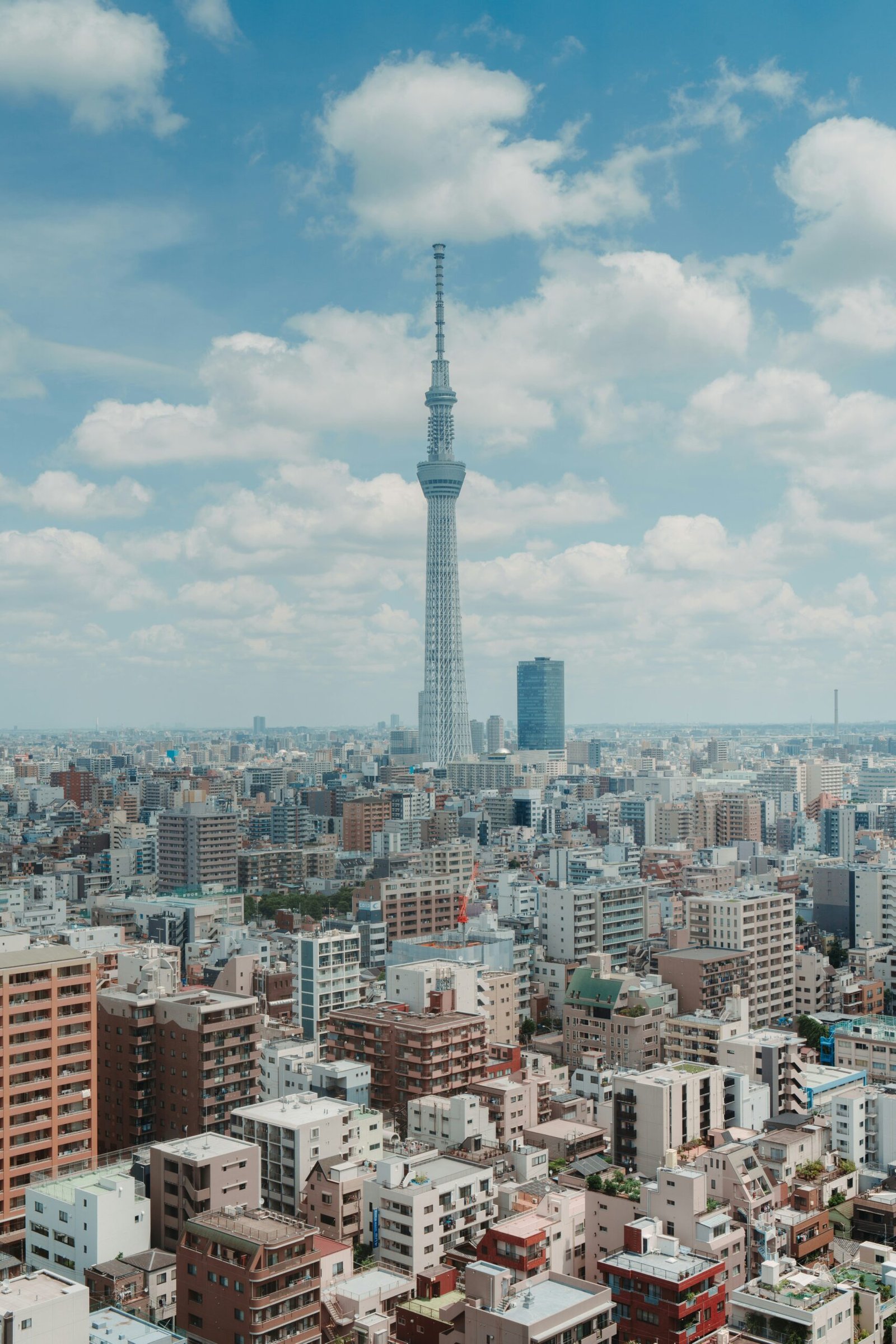
And now, let’s end your sixth day in sky-high style.
From Asakusa, cross the river or take the Tobu Skytree Line to Tokyo Skytree Station. The closer you get, the more you’ll feel your jaw drop. Tokyo Skytree Tower is 634 meters tall — the second tallest structure in the world.
Here’s how the experience breaks down:
- First observation deck (350m): ¥2,060
- Top “Tembo Galleria” (450m): +¥1,030
- Total cost: Worth it if the sky’s clear. Skip it if it’s cloudy.
What you get:
- A glass-floor walkway (gulp)
- 360° panoramic views of Tokyo — and Mount Fuji, if the weather gods smile on you
- A light show after sunset
- Plenty of shopping, cafes, and restaurants at the base, including the Skytree Town complex
Pro tip: Go around 5:30–6:00 PM to catch sunset and the night view in one visit. Golden hour from 450m up? Unreal.
Wrap the Day However You Please
You’re right by Sumida Aquarium, Tokyo Solamachi shopping mall, and plenty of casual dining options. Or head back to your hotel, legs happy and soul buzzing from yet another beautiful Tokyo day.
Day 7: Odaiba or Free Day — Your Tokyo, Your Way
Free Day Option: Revisit Your Favorites
Let’s be real. After six packed days, you might want to:
- Revisit that one temple you didn’t get enough of
- Do last-minute shopping in Ginza or Harajuku
- Or maybe just grab your favorite bento and chill in a park with Tokyo humming softly around you
Totally valid.
But if you’re still hungry for more…
Option B: Spend the Day in Odaiba — Tokyo’s Futuristic Playground
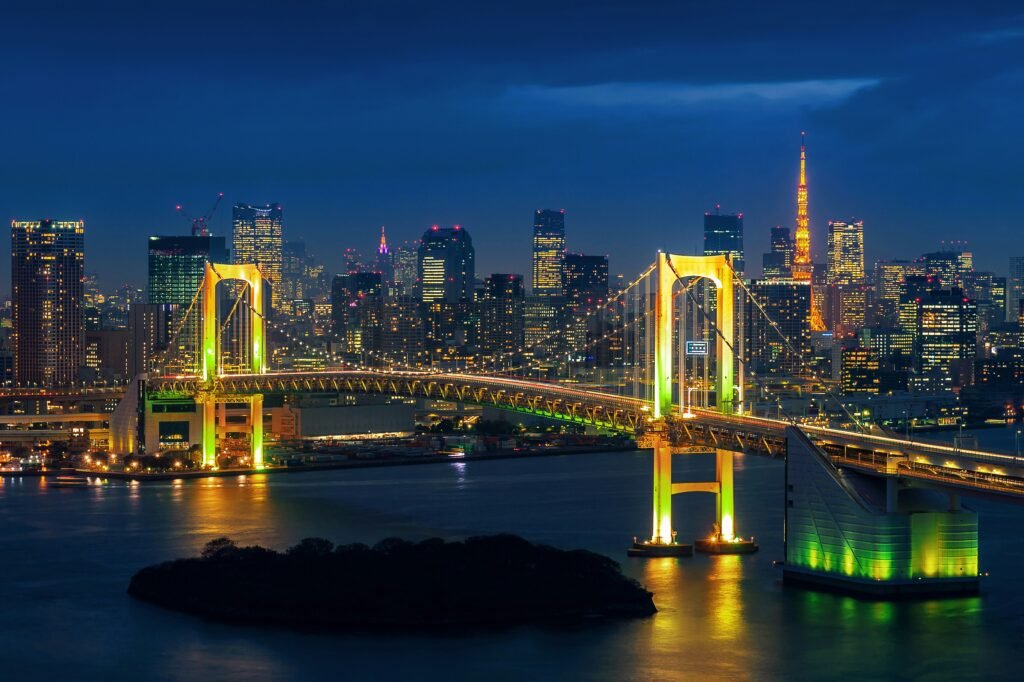
Cross the stunning Rainbow Bridge (by train or by foot if you’re ambitious), and you’ll land on the artificial island of Odaiba. It’s Tokyo at its most playful, with wide-open skies, waterfront views, and a ridiculous number of things to do.
Here’s how to spend your day:
Legoland (Yes, Really)
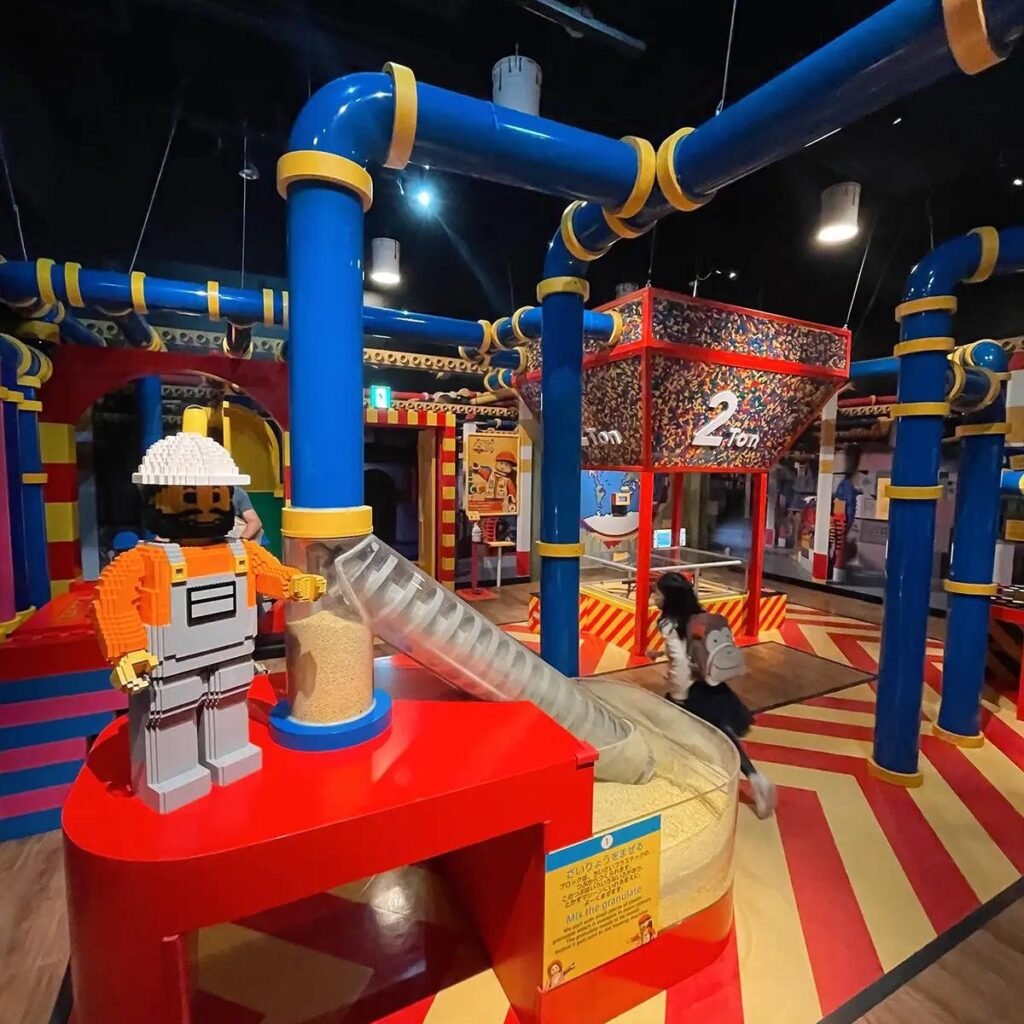
If you’re traveling with kids — or just have a soft spot for Lego — Legoland Discovery Center Tokyo is a fun way to start the day. It’s strictly for visitors with children, though, so if you’re solo or in an all-adult group, skip ahead.
Strike a Pose at the Giant Gundam Statue

Right outside DiverCity Tokyo Plaza, you’ll find a full-scale Unicorn Gundam statue. Even if you’ve never seen the anime, it’s wildly impressive. Several times a day, it transforms — lights up, moves slightly, and plays dramatic soundtracks. It’s goofy, nerdy, and iconic.
Hungry? Step inside DiverCity for lunch. You’ll find food courts with sushi, ramen, burgers, and everything in between.
Joypolis: Digital Chaos in the Best Way
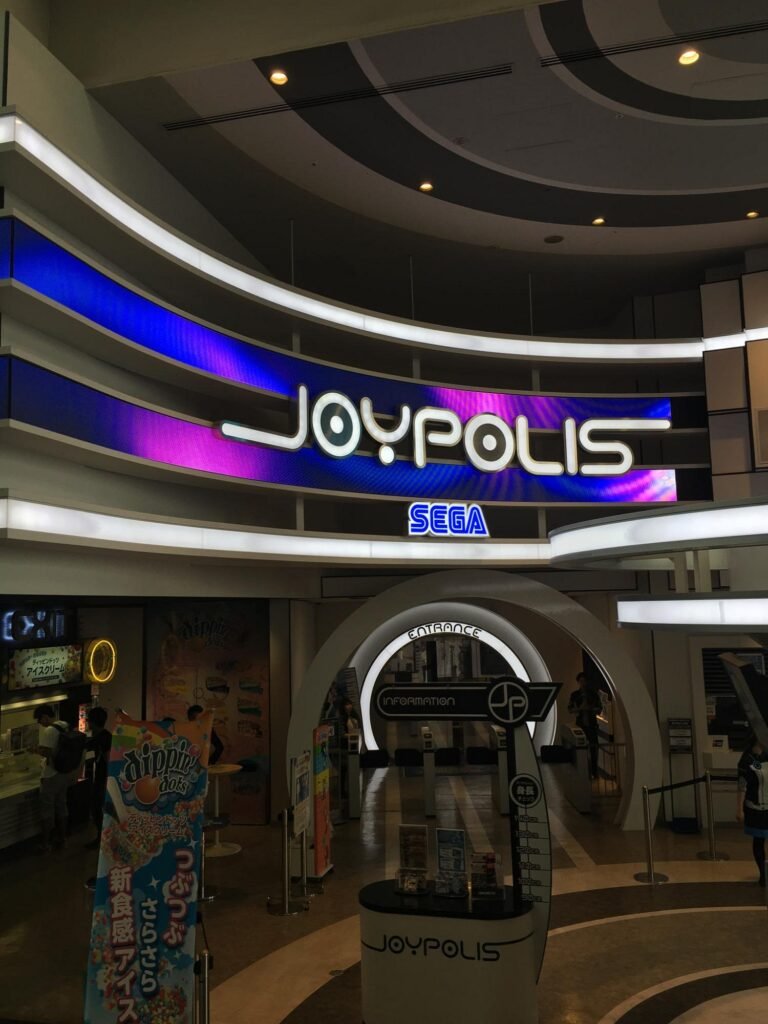
Next stop: Joypolis — an indoor amusement park and VR wonderland by Sega. This place is pure sensory overload in the best way. Think:
- 3D roller coasters
- Interactive horror games
- Neon, thumping music, and motion rides that might make you scream or laugh — or both
Great for teens, gamers, and anyone who still feels 12 on the inside.
Chill at Odaiba Seaside Park
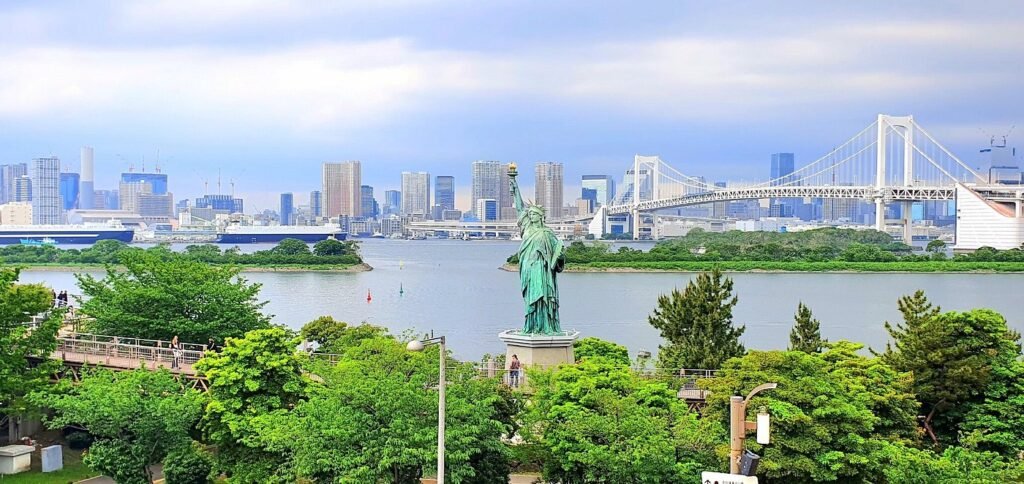
Need a breather? Walk it off along the Odaiba Seaside Park boardwalk. Yes — Tokyo has a beach. You can:
- Dip your toes in Tokyo Bay
- Watch paddle boarders and tiny boats float past
- Catch views of the skyline and mini Statue of Liberty (yes, she’s there — long story, don’t question it)
It’s the perfect spot for photos, fresh air, and watching the sunset behind Rainbow Bridge.
- What to Do in Yokohama with kids: 20+ Must-See Spots & Experiences (2025)

- 10 Best Tokyo Tours You Absolutely Can’t Miss in 2025 (From Foodie Walks to Cultural Adventures)
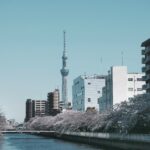
- 10 Best Tokyo Art Museums You Can’t Miss in 2025 (Modern, Traditional & Hidden Gems)

- 5 Most Beautiful Ryokan In Japan: Unwind in Timeless Tranquility [2025 Updated]
![5 Most Beautiful Ryokan In Japan: Unwind in Timeless Tranquility [2025 Updated] 4 Most Beautiful Ryokan In Japan](https://tokyocandies.com/wp-content/uploads/2023/07/247309602-150x150.jpg)
- 16 Most Romantic Hotels In Tokyo: Dreamy Stays for Couples [2025 Updated]
![16 Most Romantic Hotels In Tokyo: Dreamy Stays for Couples [2025 Updated] 5 Most Romantic Hotels In Tokyo](https://tokyocandies.com/wp-content/uploads/2023/07/thula-na-p59ux9myc74-unsplash-150x150.jpg)
